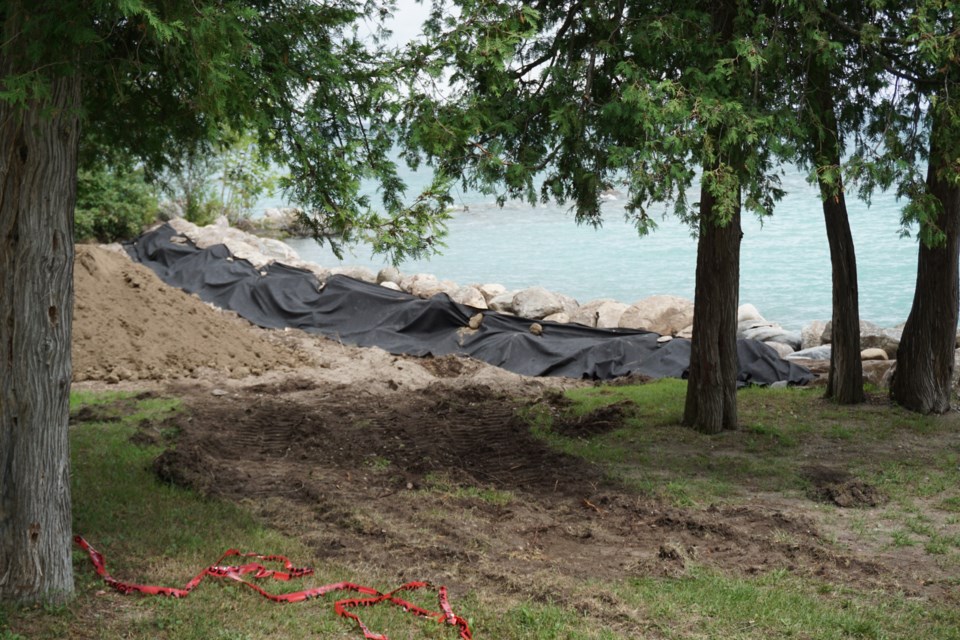South Georgian Bay residents who may be looking to beef up their shoreline protection are reminded - you might need a permit for that.
“We are spending a lot of time down in Meaford, Thornbury and the Town of the Blue Mountains (TBM),” said Andy Sorensen, environmental planning co-ordinator for Grey Sauble Conservation Authority (GSCA).
According to Sorensen, GSCA has received approximately 190 permit applications so far this year.
Sorensen added water levels have been especially high in recent years, which has exacerbated many issues along the shoreline.
“The Lake Huron, Michigan complex, are setting records right now as far as monthly averages,” Sorensen said. “ In May, the Lake Michigan-Huron monthly mean level was 89 cm above average and 21 cm above last May.”
GSCA operates within the framework of the Development, Interference with Wetlands and Alteration to Shorelines and Watercourses Regulation (also known as Ontario Regulation 151/06), which was put in place by the provincial government in 2006 and is specific to the Grey Sauble Watershed.
So, what exactly is regulated along the shoreline by GSCA? All construction, reconstruction, erection or placement of a building or structure of any kind, any change in use, any change in size, structure or number of units on the property, site grading, temporary or permanent placing, dumping or removal of any materials.
Repair or replacement of existing shoreline protection requires a permit from GSCA, and may require consultations with an engineer.
Installing new erosion protection requires both a permit and support from a qualified coastal engineer.
Some landscaping projects that involve grade changes or new structures may also require a permit.
According to TBM director of operations, Shawn Carey, the Ministry of Natural Resources and Forestry has implemented a streamlined approach to ensure property owners can conduct erosion control, such as the installation of breakwalls or armour stone, in a timely manner.
Carey says this approach clearly outlines which shoreline protection measures do not require a permit.
“The town has also been permitting shoreline property owners to utilize town-owned waterfront parcels (road allowances, drainage conveyances, etc.) for construction access to their shoreline,” Carey adds.
GSCA board member Paul Vickers recently brought up his concern at a board meeting over properties that are currently sitting dangerously close to the waterfront.
“What happens if part of their house goes into the water eventually? Will they be allowed a permit to rebuild?” asked Vickers.
Sorensen says that every case is slightly different and specific site conditions need to be taken into consideration.
“We would recommend that they get a coastal engineer involved to design a protection order. If they can set the house back further then all the better,” Sorensen said.
“If they have to reclaim some land into the Bay then the Ministry would be involved in that,” he added.
Vickers also noted his concern about shoreline residents trying to build up their properties with too small of material that may be washed into the Bay.
Sorensen said that adding materials to the shoreline, like stones for protection, requires a permit from GSCA, who would seek the guidance of a coastal engineer if necessary.
“The coastal engineer will look at the dynamics of that stretch of the shoreline and determine a more site-specific crush level,” he explained.
Earlier this year, in conjunction with Saugeen Valley Conservation Authority, GSCA held a number of workshops to review the permitting process and the current regulations.
The workshops were sponsored by Environment and Climate Change Canada and the Lake Huron Coastal Centre.
According to Carey, the conservation authority also held a meeting with TBM and Meaford staff in late December to “initiate discussions pertaining to the rising water levels and information that would assist residents to understand the various approval requirements and processes for protecting the shoreline,” he says.
As a result of these meetings and workshops, GSCA has also developed a number of fact sheets and resources to help residents navigate the permit process.
For more information, visit https://www.greysauble.on.ca/submitting-permit-and-planning-applications-during-covid-19/ or contact [email protected].



